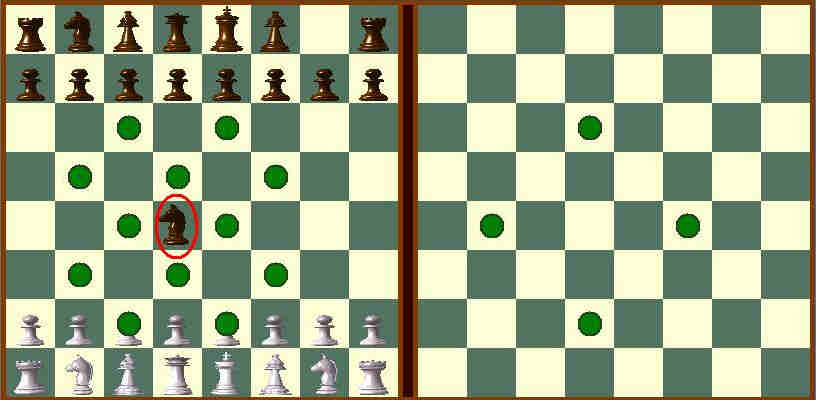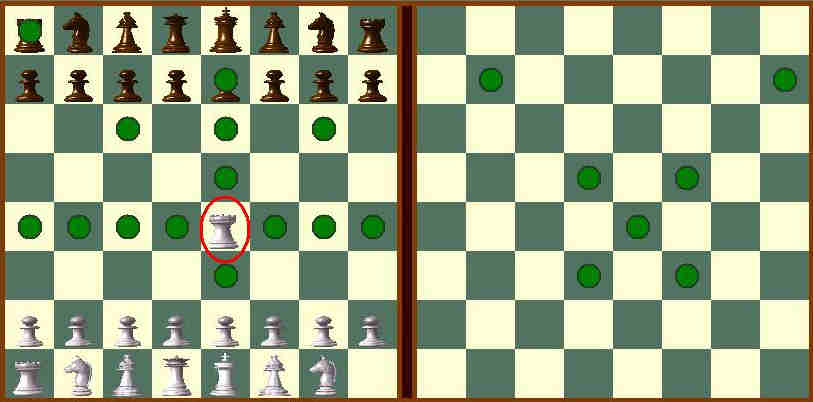Mapped Chess
This Chess Game is a mapped version on two boards of Cross 3D game, which extended naturally the power of moves of usual pieces in 3D, and kept their relative strenght.
"Mapped Chess" keeps 3D Chess new degrees of freedom while still being a 2D Game easily manageable. Indeed, the flaws usually attributed to 3D Chess are avoided: difficulty to visualise, difficulty to manage when dealing with too many pieces, difficulty to maintain pieces strength balance going from 2D to 3D, and most of all, difficulty to lead to an end by checkmating a constantly fleeing King.
It should keep the game "familiar" to orthodox game players, but provide a bunch of new possibilities.
Setup
The setup consists in two boards, one representing the odd levels and the other the even levels in 3D. The boards are put side by side, but oriented 90°, so that white squares on one board correspond to black's on the other. The initial Pieces positions are the usual ones, on one of the boards.
Pieces
The pieces are usual ones with the addition, in a second variant, of a set of white and black "Protective Pawns" (see below), possibly with some marks to distinguish them from normal Pawns, placed on the corresponding locations on the other board.
Rules
The rules are the traditional Chess Rules for en-passant capture, promotion, initial two-steps, castling, checks, mate, stalemate. The Objective is to checkmate the oponent King. But Pieces have extended movements coming from the 3D additional dimension mapped on 2D:
The Knight: As in 3D it controls squares arranged on a spherical shell (respecting a 2 by 1 jump in any direction), when you decide to map this on two boards, one for odd levels and one for even ones, you first get additional controlling squares of four orthogonal steps on the current board, and four orthogonal jumps on the other. 
The Bishop: In 3D, it moves across the squares edges in 12 directions, remaining on the same colour. When you map this on the even and odd levels boards, you get additional orthogonal moves alternately on the two boards. The Bishop gets thus an additional truncated Rook movement ! Of course, any piece standing in its way on either board interrupts the move. 
The Rook: I chose to merge the usual Rook in 3D (orthogonal moves in 6 directions) with the so-called Unicorn triagonal movement (across the corners of the cubes). There are two reasons for this: One is that it appears natural for the rook to move along alternate colours. Second, the analysis reveals that the Rook needs exactly those additional movements to keep its relative strength. When mapped on two boards, the "super" Rook now gets additional diagonal moves alternatively upon them. Hence, it receives Bishop-like truncated movement. Like the Bishop, any piece placed in between hinders its way. It is interesting to note the symmetry between Rooks and Bishop about their mutual displacements. 
The Queen is a combination of Rook and Bishop (actually, some movement being redundant, the Queen looses a bit of its relative strength) 
The King has got one step Queen movement and is able to castle (also it may not be justified) 
The Pawn gets a complementary Bishop (for capture) and Rook (for advancing move) one way step movement. But it can ONLY move without capture when none of the controlled squares are occupied, and it can make double move initially, and promote. 
In the second variant (recommended), "Protective Pawns" placed on top of the others on the other board, can neither move nor capture, but can be captured by enemy: their role is to protect initially the King from direct attacks. 
Globally, each piece has twice as much squares under control for double space, so that their relative strength remains the same (according to ZOG, if the Pawn value is 1, the Queen gets about 9, the Rook 5, the Bishop 4 and the Knight 3.5. However, they control two to three times more squares on their current board compared to the other board, asymmetry that one should keep in mind when seeking a strategy.
Notes
We have checked that a bare King can be mated against the following combinations: (K+Q), (K+R+R), (K+R+N), (K+R+B), (K+B+N). We can now proceed to show a simple test Games. Capital letters correspond to the second board. The first one was (badly) played by Zillion of Game engine against itself, but gives a feeling of the Play: We can see the pressure of the black pieces building up around the exposed King until the final sad fate occurs. 1. Ke1 - E1 Rh8 - E5+ 2. Pd2 - E3 Qd8 - A5+ 3. Pb2 - C3 Nb8 - c6 4. Pa2 - c4 Pa7 - c5 5. Nb1 - B3 QA5 - D5 6. Ra1 - B2 Ph7 - G6 7. Bf1 x f7+ Ke8 x f7 8. RB2 - A2+ Kf7 - e8 9. Qd1 - C2 PG6 - G5 10. Ph2 - G3 Ng8 - f6 11. Rh1 - f3 QD5 - H1+ 12. Bc1 - F1 QH1 - G1+ 13. KE1 - E2 Nf6 - e4+ 14. KE2 - D2 Nc6 - d4+ 15. KD2 - D1 QG1 x F1+ 16. KD1 - d1 QF1 x g1+ 17. Kd1 - C1 Nd4 x f3 18. Pg2 x f3 Bf8 x f2 19. QC2 - f5 Ne4 - c3+ 20. KC1 - D2 Qg1 - e1+ 21. KD2 - D3 Qe1 - e3 mate 0-1 The second longer one I find more instructive: We follow the white pieces building up a safe place for their King on the other board, then harass the enemy King from one side of the board to the other side by vicious checks that pick up a few pieces in passing, until finally the black King falls. 1. P a2 - a3 R h8 - d4 2. N g1 - f3 R d4 - a4 3. N f3 - e5 P d7 - f5 4. Q d1 - b3 R a4 - a5+ 5. B c1 - c3 R a5 x c3 6. R a1 x c3 N g8 - h6 7. Q b3 - b5+ P c7 - c6 8. Q b5 - E5+ P e7 - e6 9. Q E5 - E6 Q d8 - h4 10. N e5 - f3 Q h4 - H4+ 11. K e1 - D1 B f8 - f6 12. Q E6 - C8 B f6 x c3 13. N b1 x c3 Q H4 - H5+ 14. P e2 - F3 Q H5 - B5 15. Q C8 - C2 R a8 - A8 16. R h1 - H1 N h6 - g4 17. N c3 - b3 R A8 - D8+ 18. N b3 - D3 N b8 - d7 19. R H1 � H7 R D8 - G8 20. P h2 - G3 Q B5 - A6 21. R H7 - H5+ K e8 - D7 22. Q C2 - F2 N g4 - e5 23. N f3 x e5 N d7 x e5 24. Q F2 - D4+ K D7 - E7 25. Q D4 - E4+ K E7 - d7 26. Q E4 - d4+ K d7 - E7 27. R H5 - H7+ K E7 - F6 28. R H7 - H4+ K F6 - E7 29. Q d4 x e5 P g7 - F6 30. R H4 - E4+ K E7 - f8 31. B f1 - h1 K f8 - g8 32. B h1 - d1 Q A6 - B6 33. Q e5 - g5+ K g8 - F7 34. Q g5 - D5+ K F7 - g8 35. Q D5 - d8+ K g8 - G7 36. Q d8 - D7+ K G7 - h6 37. Q D7 x c8 Q B6 - B1+ 38. K D1 - e2 K h6 - H7 39. Q c8 - D7+ K H7 - g8 40. R E4 x b7 R G8 - G7 41. B d1 - D8+ K g8 - G8 42. R b7 x f7+ K G8 x f7 43. B D8 - d7+ K f7 - f6 44. Q D7 x G7+ K f6 - e5 45. N D3 - E3+ K e5 - d6 46. Q G7 - C7+ K d6 - c5 47. Q C7 x c6+ K c5 - B4 48. B d7 - D6+ K B4 - A5 49. Q c6 - a6 mate 1-0 These Games let one imagine the wealth of new situations that can occur in the Game, with very strong threats from long range pieces which can now in some way jump over obstacles in the current board through the other board. The Queen is especially dangerous, although being slightly less powerful than in 2D, when she approaches with support of the enemy King from the other board. Finally, The Game was edited in the english "Variant Chess" Magazine Vol.7, issue 54 This 'user submitted' page is a collaboration between the posting user and the Chess Variant Pages. Registered contributors to the Chess Variant Pages have the ability to post their own works, subject to review and editing by the Chess Variant Pages Editorial Staff.
This 'user submitted' page is a collaboration between the posting user and the Chess Variant Pages. Registered contributors to the Chess Variant Pages have the ability to post their own works, subject to review and editing by the Chess Variant Pages Editorial Staff.
By Stephane Burkhart.
Last revised by Stephane Burkhart.
Web page created: 2007-10-18. Web page last updated: 2007-10-18
